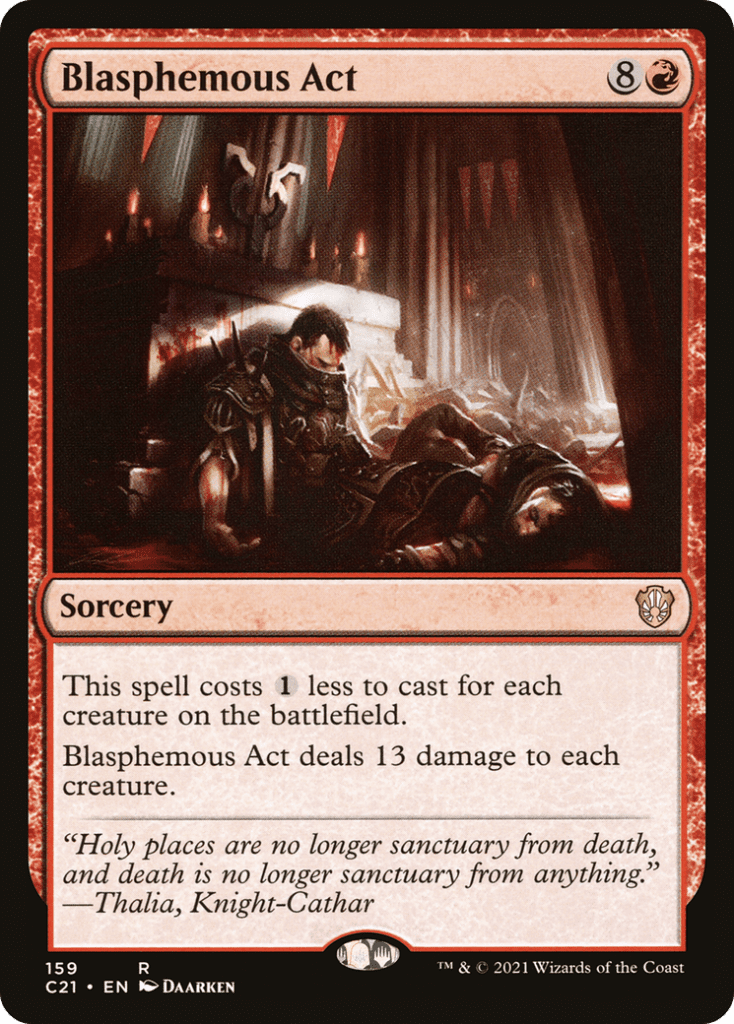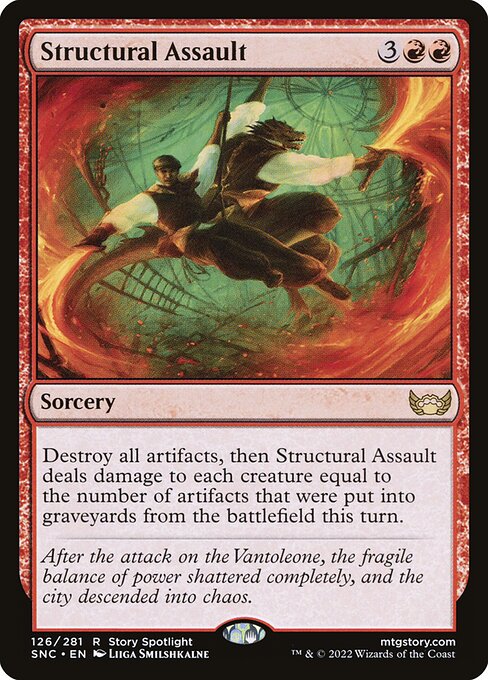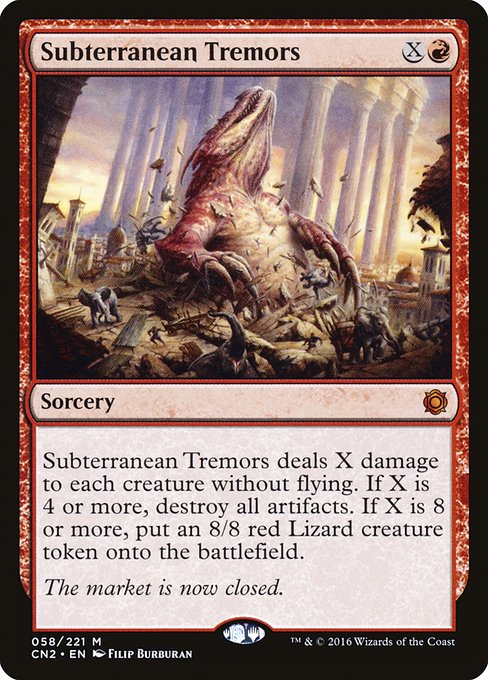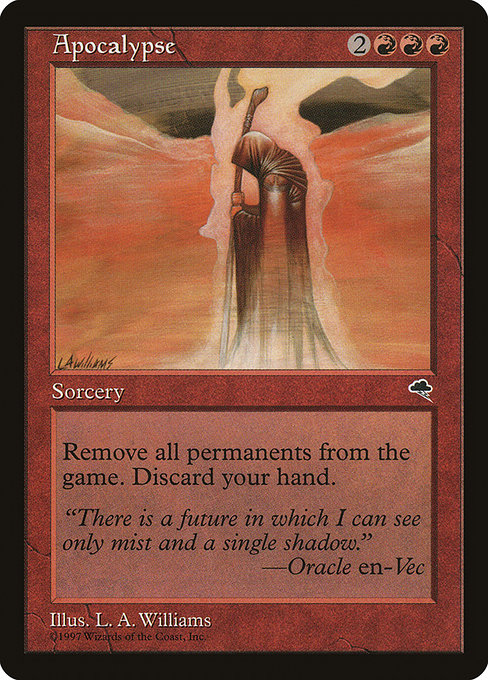Sometimes, a board state is simply too complicated for its own good. The token deck has a huge swarm of creatures, but is being held in check by a pillow fort deck that taxes attackers with mana payments. An artifact combo deck watches this balance with interest, looking for an opportunity to combo off and win from out of nowhere.
And you, the red player, have had enough. It’s time to simplify matters and shake this precarious balance of power to its core.
It’s time for a board wipe.
What is a Board Wipe in MTG?

A board wipe is a mass removal spell that removes all creatures from the battlefield by bouncing, destroying, or exiling them. This definition can also be expanded to include other permanent card types, such as artifacts, enchantments, planeswalkers, and lands.
While these are generally unwelcome sights when you’re in a commanding board position, board wipes can deliver significant card advantage and restore all players’ battlefields to more equal footing if you’ve fallen behind or see the set up for a devastating combo on another player’s battlefield.
Despite creatures being the most common permanent type to trigger someone’s need to cast a mass removal spell, board wipes come in a pretty wide variety of flavors depending on the color being discussed. Red is no exception, so let’s take a look at where its most destructive spells excel.
How Do Red’s Best Mass Removal Spells Work?
Red’s board wipes don’t typically destroy creatures outright, focusing on dealing them enough damage to kill them instead. In the rare case you find a red board wipe that destroys creatures outside of damage, the removal is either very targeted or encompasses much more than just creature permanents.
In addition to damage effects, red has long been known for its ability to destroy all artifacts on the battlefield, dating back as far as Shatterstorm in Antiquities. While not possessing as many effects as green or white in this space, the effects it does have tend to carry low mana costs and other upsides.
Mass land destruction is also fairly common as a standalone effect, as part of an effect that also destroys artifacts and/or creatures, or as collateral damage for massive board nukes that effectively remove everything from the game.
But you’re not here for a history or color pie lesson – you’re here to learn which board wipes are going to have the biggest impact in your red Commander deck. Without further ado, let’s have a look!
Tribal Board Wipes (Draconic Intervention, Gates Ablaze, Raiding Party, Skirk Fire Marshal)




Tribal board wipes are geared toward synergy with a specific creature type or card type that is prominently featured in your deck. While this significantly restricts where you can play these mass removal spells, they usually make up for it with some very efficient or one-sided payoffs.
Gates Ablaze and Skirk Fire Marshal skew toward the efficient end of these payoffs, providing an inexpensive means of doing a lot of damage to all creatures on the battlefield.
Gates Ablaze accomplishes this through an extremely efficient mana cost – most board wipes cost a minimum of 4, and in red, it’s common for a board wipe to cost 5 or 6 mana. It also has the advantage of accruing Gate cards through lands, meaning they’ll dodge a lot of removal and still be around to generate mana for you when the dust settles.
Skirk Fire Marshal more closely fits a typical board wipe’s mana cost, but Protection from red means it won’t take damage from its own effect.
And it isn’t difficult to amass 4 more Goblins in a Goblin deck to sweep the board again if needed. Brash Taunter also combos well with this mass damage effect, providing an indestructible body that will throw the 10 damage it receives directly at an opponent of your choice. each time Skirk Fire Marshal goes off.
Draconic Intervention is arguably the most powerful of these tribal board wipes, as it doesn’t damage your own dragons and can easily deal several points of damage to opposing creatures efficiently at 4 mana. While a shame it exiles itself as part of its resolution, being able to repeatedly use this board wipe from your graveyard would be difficult to contend against.
Raiding Party is the odd duck of this batch, serving as a tribal color hoser that can repeatedly nuke Plains cards, including nonbasics like Indatha Triome. While Orcs aren’t a common creature type currently, there are more than enough Changelings (creatures with all creature types) to easily abuse this 1-sided land destruction.
Color Hosers (Anarchy, Boil, Boiling Seas, Flashfires




Color hosers, or cards that specifically target a specific color of permanent or basic land type, aren’t going to make you a lot of friends at most Commander tables, but their effectiveness against specific decks is undeniable.
Of red’s color hosing board wipes, Anarchy is arguably the least problematic, barring a combo with Painter’s Servant to turn it into a full board nuke. While this can represent a single player board wipe in an ideal scenario, simply being able to take out all permanents of a color you aren’t playing can neutralize a lot of threats very efficiently.
Better still, Anarchy is one of the few methods red can use to knock out enchantments without resorting to risky plays like Chaos Warp. When you consider that white is also the color with access to the most powerful enchantment support cards, this can make Anarchy an amazing metagame answer to a deck mono-red struggles against.
Boil, Boiling Seas, and Flashfires are all pretty specifically tailored to combat mono-blue or mono-white builds that are running a sizable number of basic lands. Each of these can nuke a specific player’s mana for a ridiculously efficient rate in the right situation, and are likely to set them so far back that they’re effectively out of the game.
It is worth noting that these spells are also fairly big threats against 5 color decks running a lot of original dual lands, shocklands, and triomes too, as the lands they destroy don’t have to be basics – they only need to have the basic land type in question.
That said, I’d be careful about playing these specific cards in Commander – mass land destruction is frowned upon outside of cEDH, and if your playgroup is prone to 2-3 hour Commander games, leaving someone effectively dead in the water for a sizable percentage of that time is likely to build some resentment.
Artifact Board Wipes (Pulverize, Shatterstorm, Vandalblast)



Shatterstorm might be the first red artifact board wipe, and while 4 mana for this effect isn’t a bad rate, it’s pretty significantly outclassed by the artifact board wipes that were printed after it.
It honestly stuns me that Pulverize doesn’t see more play. While paying 6 mana is infinitely worse than paying Shatterstorm‘s 4, you’re almost never going to have to worry about paying any mana at all thanks to the fact you can simply sacrifice 2 Mountains instead.
Granted, setting yourself back 2 lands can be a steep price in the early game, but if you’re clearing out a bunch of enemy mana rocks like Sol Ring and Mana Crypt, that can easily be a price worth paying to stop early explosive plays from your opponents.
Vandalblast, on the other hand, has seen significant Commander play for years. Destroying all opposing players’ artifacts for a mere 5 mana is an amazing deal, and the flexibility of being able to remove an artifact of your choice (that you don’t control) for 1 mana makes it a great card to have on hand during any stage of a Commander game.
Mass Land Destrutction (Boom // Bust, From the Ashes, Impending Disaster, Ruination)




Boom // Bust was a pretty big deal when Planar Chaos came out, as red had only really gotten 1 direct mass land destruction spell before it (Decree of Annihilation).
Like many mass land destruction cards before it, Commander players will typically unleash this when they have a commanding board position and are ready to close out the game by preventing new cards from being cast.
Yes, 6 mana is a pretty big ask for Bust’s effect when compared to cards like Armageddon, but having the option to destroy your opponent’s most troublesome land for 2 mana as an additional mode for this card isn’t nothing, as there are many powerful nonbasic lands roaming Commander tables like Gaea’s Cradle, Serra’s Sanctum, and Academy Ruins.
While Boom will ultimately cost you one of your lands as well, you can take steps to make this targeted effect much more one-sided. Lands like Darksteel Citadel, Cascading Cataracts or Flagstones of Trokair (if your deck also has white) give you ways to shrug off what is intended to be a symmetrical effect with ease!
From the Ashes and Ruination take a more focused approach to mass land destruction, focusing exclusively on nonbasic lands. These are generally much more accepted at Commander tables are they are designed to punish greedy manabases, and From the Ashes will also let players replace destroyed nonbasic lands with basics from their deck.
Impending Disaster is the least reliable card of the batch here. Since it requires a turn to go off, your opponents are going to focus their efforts on either enchantment removal or player removal, so you have to be ready to weather a storm of attacks and spells if players still have a lot of cards left in their hands.
2 mana is ridiculously cheap for this effect, however, so you’ll almost always have at least a few lands open to protect yourself from the abuse Impending Disaster attracts. If your deck also has access to white, Teferi’s Protection is a great combo piece to ensure your board remains undisturbed until your next upkeep.
Board Clears that Destroy Multiple Permanent Types (Jokulhaups, Obliterate, Structural Assault, Subterranean Tremors)




While we’ve talked about Boom // Bust‘s mass land destruction being a good way to keep yourself ahead long enough to close a Commander game, Jokulhaups is another great way to get the job done.
Whether paired with indestructible effects or simply clearing the way for a big threat with the last of your mana, Jokulhaups reaches creatures and artifacts in addition to lands, meaning most mana rocks and major threats that would otherwise impede your progress get destroyed for the same 6 mana you’d pay to cast Bust.
If countermagic is a constant presence in your meta, however, Obliterate is probably going to be your board clear of choice in this vein. 8 mana is a lot to ask of decks that can’t find a way around its mana cost, but barring a Teferi’s Protection or a very specialized counter like Venser, Shaper Savant or Mindbreak Trap, you generally don’t need to worry about it resolving.
Structural Assault and Subterranean Tremors are more traditional board wipes, each removing all artifacts and most creatures for 5 mana. Subterranean Tremors is the more flexible of this duo in terms of potential impact, but its inability to hit flying creatures is not outweighed by the possibility of receiving an 8/8 creature.
Structural Assault, on the other hand, stands a good chance of becoming a staple akin to Vandalblast. Mana rocks are very common in Commander nowadays, and powerful artifacts have seen play since Commander’s inception, so the odds of hitting enough permanents to clear all creatures, including fliers, are pretty high when this comes down.
Easily the best red board wipe printed in years – get your copies from Streets of New Capenna sooner rather than later.
Board Clears that Exile Multiple Permanent Types (Apocalypse, Decree of Annihilation, Worldfire)



Decree of Annihilation isn’t the boogeyman it once was in Commander, but its power still shouldn’t be underestimated. Notably excluding enchantments and planeswalkers from its destruction, decks that are focused on these strategies rarely have trouble closing a game once it exiles everything else, as everyone else is topdecking with few or no resources on hand.
Everyone else generally uses the cycling ability to destroy all lands without fear of a counterspell. Counters for activated or triggered abilities like Stifle are rare in both number and deck construction, so it’s all but certain that this effect will resolve when triggered.
Apocalypse has been my go to for a mass exile effect for years, but I may be a bit biased as a Jhoira of the Ghitu player. 5 mana is perfectly accessible for a casting cost, and with a way to move your permanents out of harm’s way or cast them from suspend or the graveyard, it has almost no equal when it comes to facilitating the end of the game.
I say almost, because after a recent unbanning, we need to talk about Worldfire.
Costing almost twice as much mana as Apocalypse at a whopping 9, Worldfire goes a bit further than its predecessor by also exiling graveyards and everybody’s hands. Then it sets all life totals to 1.
In a vacuum with no plan, you’re leaving a lot to chance at this point. Who’s going to get the first creature into play? Will it have haste? Is it worth killing off 1 player to potentially leave yourself open to another?
That said, these aren’t generally questions the table needs to concern themselves with. The person playing it has already come up with a plan to manipulate the stack to deal that crucial one point of damage as soon as Worldfire resolves, or has found a way to get a creature like Inferno Titan onto the battlefield afterward to do it for them.
Storm’s Wrath

Storm’s Wrath is a card I remember seeing when it was previewed, then I proceeded to forget all about it because –gestures to the state of the world in early 2020-. I can’t imagine I’m the only person this card has flown under the radar for, and upon looking at it, I think that’s a mistake.
4 damage will actually kill the vast majority of commonly played creatures in Commander currently, as the format has shifted from battlecruiser Magic to faster play patterns and efficient creatures with potent effects. Red just doesn’t get 4 mana Wrath of God effects, so having access to 1 is actually a really big deal here.
The fact that Storm’s Wrath also hits planeswalkers isn’t as important, as these rarely see play outside of dedicated planeswalker decks, but 4 damage will take a sizable chunk of their loyalty out from under them in those rare cases that it comes up, which is pretty nice incidental upside.
That said, this fixed 4 damage is the biggest strength and weakness of this board wipe. On one hand, if you have creatures with at least 5 toughness, you suddenly have a lot of open boards to go attack. On the other, if your opponent is playing the big creature deck, Storm’s Wrath is likely to come up short much of the time.
Ultimately, this means that Storm’s Wrath isn’t for every deck or situation, but there are many that stand to benefit from it, and I’m excited to give it a spin in my Mayael the Anima deck.
Puppet’s Verdict

If you thought a 4 mana board wipe was cool, let me show you the 3 mana board wipe nobody’s talking about in Puppet’s Verdict.
At instant speed, you get to flip a coin. If you win, creatures with power 2 or less are destroyed. If you lose, creatures with power 3 or greater are destroyed instead.
I’ll admit, a 50% success rate isn’t exactly something anyone’s going to be bragging about in many situations – it’s why potentially powerful cards like Stitch in Time don’t see play either. But unlike Stitch in Time, you still get some mileage out of Puppet’s Verdict regardless of how the coin flip resolves, and that’s frequently very relevant.
Having played this card a fair bit, I’ve been pleasantly surprised by its effectiveness more often than not, and in a worst case scenario, you play it at the end of an opponent’s turn, don’t get the outcome you want, and play a second board wipe on your turn for the desired result.
Starstorm

Instant speed board wipes are insanely powerful, and in red, you aren’t going to find a more reliable one than Starstorm.
I’ve played this card for years, and can’t tell you the number of times an opponent thought they were swinging for game with a bunch of big creatures, infinite Pestermites, or some other nonsense only for me to clear the board and leave my would-be attacker defenseless during their turn.
The ability to set your damage with the X casting cost is also extremely relevant, as you can often manipulate the board state very favorably by leaving your strongest threat in play. And if you draw it too early in a game, you can cycle it for 3 mana to draw a replacement card!
Nowadays, there are a lot more board wipes in the world, so Starstorm isn’t going to be quite as efficient compared to the new kids on the block, but it still packs a wallop, and always has a good shock factor stapled to a big swing in tempo when played at the right time.
Hour of Devastation

I’m not sure how I feel about how easy it is to find indestructible creatures or ways to make them indestructible nowadays. In many cases, I find it very beneficial as I can keep my big threats in play more easily, but in several others, I just haven’t had a viable way to work around my opponents doing the same without a removal spell that exiles.
Hour of Devastation isn’t an answer to this conundrum, but it has definitely been a valuable tool for combating my opponents’ shenanigans.
5 damage for 5 mana is already a solid rate, and will much more reliably clear a board than Storm’s Wrath, while doing so less expensively than Starstorm. The real effect that truly makes it one of red’s premier board wipes, however, is the fact that it strips the indestructible keyword from all creatures until end of turn.
No more hiding behind Darksteel Plate. Don’t bother casting that Heroic Intervention. Not even Avacyn, Angel of Hope can save you now.
Hour of Devastation also hits planeswalkers, which is also relevant, as 5 damage is much more likely to kill them outright than 4. Again, not something that comes up super often, but really handy in the rare cases it matters.
Oh, and then there’s the opportunity for an evil laugh if you’ve got a Nicol Bolas, Dragon-God (or any of Bolas’ other iterations) out when you cast Hour of Devastation. Mustn’t forget that – it’s arguably the most important part.
Chain Reaction

Chain Reaction has been one of the best red board wipes ever printed for multiplayer Magic since Worldwake, and I don’t see that changing anytime soon. Just tally up the number of creatures on the battlefield, cast this for 4 mana, and every creature takes that amount of damage.
Spoiler: It’s almost never less than 8.
Like other damage-based board wipes, you can get cute by combining it with effects like Everlasting Torment to get around indestructibility or Stuffy Doll to also deal your least favorite opponent a ton of damage, but none of that is truly necessary here.
Chain Reaction goes in, takes out the trash, and leaves you with the opportunity to build a better board state, often with plenty of mana left over. What’s not to love?
Blasphemous Act

I literally don’t know what Wizards was thinking when they printed Blasphemous Act. This card almost never costs more than 1 mana, deals 13 damage to all creatures, which will almost always clear a board, and it doesn’t restrict you from rebuilding your forces the turn you cast it.
Weirdly, this card didn’t catch on right away when it was originally printed in Innistrad. People didn’t sleep on it long though, and it will be a Commander mainstay until every creature is printed with Indestructible, at which point we’ll still probably see it, just in combination with some other effect that redirects or abuses creature damage.
How Many Board Wipes Should I Play in EDH (Commander)?
The answer to this question can vary quite a bit, depending on your deck’s focus and underlying strategies. My builds rarely run fewer than 4 cards that can act as board wipes, with a suite of targeted removal spells to back them up. In more controlling strategies where I need to keep creatures off the table, I’ve played as many as 12.
Most of my Commander decks usually have 4-5, occasionally moving up as high as 6 board wipes if they need an extra out against decks that swarm the table with creatures or artifacts. Do a little experimenting and take the decks in your meta into account – you can always add more or take some out as needed while playtesting and tuning your deck!
Other MTG Articles You Might Enjoy
- Best Artifact Equipment for an Equipment Deck
- Cheap Mana Rocks for Commander Decks
- Good Black Tutors for Commander
- Reanimator Commanders You Should Try
- Token Commanders You Should Try
Braden is a founder of Assorted Meeples and has been a gamer & writer with a vivid imagination all his life. Don’t believe us? Check out his excitement when meeting Goosebumps author R.L. Stine as a kid! An avid Magic: The Gathering spellslinger for over 15 years, you can always convince him to shuffle up for a game (or three!) of Commander.
